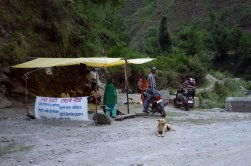Article and Image courtesy: International Rivers
Author: Samir Mehta
Samir Mehta from International Rivers journeys Himachal Pradesh and writes about the severe impacts of small hydro projects on communities and ecosystems.
 Protesters take turns sitting at road to block dam construction
Protesters take turns sitting at road to block dam construction
India’s rivers and streams are threatened by a massive hydropower rollout. Large projects in the northern, mountainous states will have the biggest impacts, but the smaller ones, which are cropping up all over the country, are having serious impacts on local people’s lives. Indeed, the High Court of the state of Karnataka has halted the implementation of a number of mini- and micro-hydel projects in the Western Ghats region of the state pending a cumulative impact assessment. During my recent visit to the north Indian state of Himachal Pradesh I also surveyed many mini- and micro-hydel projects.
The Gujjar and Gaddi tribes in the state of Himachal Pradesh are fully prepared for a long battle to stop a 4.5 MW hydropower plant from diverting the entire flow of the Hul stream, on which their lives depend. For the past three months the tribe members take turns to sit by the road at Jadera village and stop all vehicles associated with the project from travelling to the site. This happens under the nose of the state police hired by the project proponent to ensure protection of their project. The police have registered cases against more than 50 of them for blocking the road. The tension is palpable.
Shops in potentially dam affected area
The Gujjar tribe keep buffaloes. They supply roughly half the dairy products used by nearby Chamba town. The Gaddi tribe rear goats and sheep. They have evolved their own system on who would sit by the road and when so that there’s no adverse impact on their earnings. Food is provided to the squatters by the families in turns. Their pride will not let them accept financial support from others. They politely refused my offer.
These communities have for more than a decade protected and preserved the forests from which the Hul stream originates. Traditional watermills line its banks, extensive irrigation channels feed terraced vegetable farms, children bathe in silver pools, and lush oak forests run parallel along steep slopes. The stream meets Saal River which joins the might Ravi River. Mr. Ratan Chand from nearby Chamba town was instrumental in raising awareness of the need to protect and preserve the oak forests. The project’s pipeline will destroy about 2,000 of the slow-growing oak trees. Oak trees, a tribesman said, retain and release four times the amount of water than most other trees do. That is why, he adds, the stream is perennial.
“Government should protect forests. We are doing the Government’s job,” said a Gujjar leader. “The right to the river is ours. Why should anyone take away our water through pipes,” said a Gaddi leader. “We will go to jail and others will take our place” in the campaign to protect the stream, said a woman at the roadside checkpoint, adding, “We have faced bullets; going to jail is nothing in comparison.”
While the police harass the protestors, thugs allegedly hired by the project proponent who have attacked the villagers with guns roam scot-free.
 Ratan Chan talking to tribes people
Ratan Chan talking to tribes people
Livelihood and social impacts of poorly planned run-of-the-river mini hydel projects can be devastating, as exemplified in this case. The project, named HUL-1, will generate a mere 4.5 MW by diverting the entire flow of Hul stream to the power house through pipes. These tribes will be left high and dry. The 65 traditional watermills will grind to a halt as will fishing in the waters.
Time and again the villages passed resolutions not to permit the hydropower plant. But the High Court of the state of Himachal Pradesh has permitted the developer to continue with the project under state police protection while also permitting the people to protest peacefully. The people are adamant that they will not allow the project. One who holds out the longest will win. Only time will tell who that is.